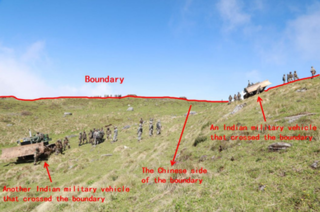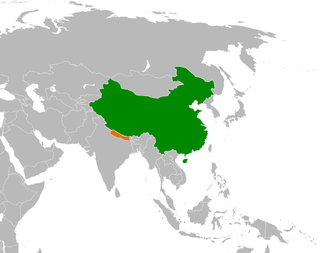
TheRepublic of India, has diplomatic relations with 201 states around the globe, having 199 missions and posts operating globally while plans to open new missions in 2020-21 hosted by 11 UN Member States.

Though the Ministry of Foreign Affairs (MOFA) is the government agency responsible for the conduct of foreign relations of Nepal, historically, it is the Office of Prime Minister (PMO) that has exercised the authority to formulate and conduct policies related to Nepal's foreign affairs. As a landlocked country wedged between two larger and far stronger powers, Nepal has tried to maintain good relations with both of its neighbors, People's Republic of China and Republic of India. However, its relationship with India, remains utmost priority due to open border and similarity in culture, tradition, geography, living practices. The relationship between the two countries was significantly hampered during the 2015 Nepal blockade. Where the Nepal Government accused India of the blockade, India strictly denied the allegation and said the blockade were imposed by Madheshi protesters. For the most part though, Nepal has traditionally maintained a non-aligned policy and enjoys friendly relations with its neighboring countries and almost all the major countries of the world.
The Five Principles of Peaceful Coexistence, also known as Panchsheel, were mentioned in the preamble of the Sino-Indian Agreement 1954. The principles subsequently adopted in a number of resolutions and statements, including the preamble to the Constitution of China.

The McMahon Line is the boundary between Tibet and British India as agreed in the maps and notes exchanged by the respective plenipotentiaries on 24-25 March 1914 at Delhi, as part of the 1914 Simla Convention. The Republic of China was not a party to the McMahon Line agreement, but the line was part of the overall boundary of Tibet defined in the Simla Convention, initialled by all three parties and quickly repudiated by the government of China. The Indian part of the Line currently serves as the de facto boundary between China and India, although its legal status is disputed by the People's Republic of China. The Burmese part of the Line was renegotiated by the People's Republic of China and Myanmar.

The Line of Actual Control (LAC) is a notional demarcation line that separates Indian-controlled territory from Chinese-controlled territory in the Sino-Indian border dispute. The term is said to have been used by Zhou Enlai in a 1959 letter to Jawaharlal Nehru. It subsequently referred to the line formed after the 1962 Sino-Indian War and is part of the Sino-Indian border dispute.

The Simla Agreement, also spelled Shimla Agreement, was a peace treaty signed between India and Pakistan on 2 July 1972 in Shimla, the capital city of the Indian state of Himachal Pradesh. It followed the Indo-Pakistani War of 1971, which began after India intervened in East Pakistan as an ally of Bengali rebels who were fighting against Pakistani state forces in the Bangladesh Liberation War. The Indian intervention proved decisive in the war and led to East Pakistan's breakaway from its union with West Pakistan and the emergence of the independent state of Bangladesh.

China–India relations, also called Sino-Indian relations or Indo–Chinese relations, refers to the bilateral relationship between the People’s Republic of China and the Republic of India. India and China had historically maintained peaceful relations for thousands of years of recorded history. But the harmony of the relationship has varied in modern time, especially after the rule of the Communist Party in China; the two nations have sought economic cooperation with each other, while frequent border disputes and economic nationalism in both countries are a major point of contention. The modern relationship began in 1950 when India was among the first countries to end formal ties with the Republic of China (Taiwan) and recognise the People's Republic of China as the legitimate government of Mainland China. China and India are two of the major regional powers in Asia, and are the two most populous countries and among the fastest growing major economies in the world. Growth in diplomatic and economic influence has increased the significance of their bilateral relationship.
Strategic Foresight Group (SFG) is a think tank based in India that works on global issues. It was established in 2002.

The Sino-Indian border dispute is an ongoing territorial dispute over the sovereignty of two relatively large, and several smaller, separated pieces of territory between China and India. The first of the territories, Aksai Chin, is administered by China as part of the Xinjiang Uygur Autonomous Region and Tibet Autonomous Region and claimed by India as part of the union territory of Ladakh; it is the most uninhabited high-altitude wasteland in the larger regions of Kashmir and Tibet and is crossed by the Xinjiang-Tibet Highway, but with some significant pasture lands at the margins. The other disputed territory is south of the McMahon Line, formerly known as the North-East Frontier Agency and now called Arunachal Pradesh. The McMahon Line was part of the 1914 Simla Convention signed between British India and Tibet, without China's agreement. China disowns the agreement, stating that Tibet was never independent when it signed the Simla Convention.

India's Look East policy is an effort to cultivate extensive economic and strategic relations with the nations of Southeast Asia to bolster its standing as a regional power and a counterweight to the strategic influence of the People's Republic of China. Initiated in 1991, it marked a strategic shift in India’s perspective of the world. It was developed and enacted during the government of Prime Minister Narsimha Rao (1991–1996) and rigorously pursued by the successive administrations of Atal Bihari Vajpayee (1998–2004) and Manmohan Singh (2004–2014).

Doklam, Zhoglam, or Donglang, is an area with a plateau and a valley, lying between China's Chumbi Valley to the north, Bhutan's Ha Valley to the east and India's Sikkim state's Nathang Valley to the west. It has been depicted as part of Bhutan in the Bhutanese maps since 1961, but it is also claimed by China. To date, the dispute has not been resolved despite several rounds of border negotiations between Bhutan and China. The area is of strategic importance to all three countries.

The 2017 China India border standoff or Doklam standoff refers to the military border standoff between the Indian Armed Forces and the People's Liberation Army of China over Chinese construction of a road in Doklam near a trijunction border area, known as Donglang, or Donglang Caochang, in Chinese. On 16 June 2017 Chinese troops with construction vehicles and road-building equipment began extending an existing road southward in Doklam, a territory which is claimed by both China as well as India's ally Bhutan. On 18 June 2017, as part of Operation Juniper, about 270 Indian troops armed with weapons and two bulldozers crossed the Sikkim border into Doklam to stop the Chinese troops from constructing the road. On 28 August, both India and China announced that they had withdrawn all their troops from the face-off site in Doklam.

The Sino-Nepalese Treaty of Peace and Friendship was an official settlement between the governments of Nepal and China signed on 28 April 1960, which ratified an earlier agreement on the borders separating the neighboring nations from each other. Gerry Van Tronder has argued that this document fitted into an attempt to maintain the image that Beijing was a "powerful but essentially benevolent leader in Asia", following the 1959 Tibetan Uprising. Contemporary Nepali, Chinese and Indian commentators have stressed the importance of the treaty in determining Nepal's relationship with China in the past and present.
Longju or Longzu is a disputed area in the eastern sector of the China–India border, controlled by China but claimed by India. The village of Longju is located in the Tsari Chu valley 2.5 kilometres (1.6 mi) south of Migyitun, which was the historical border of Tibet. The area southwards of Longju is populated by the Tagin tribe of Arunachal Pradesh.

The Border Peace and Tranquility Agreement is an agreement signed by China and India in September 1993, agreeing to maintain the status quo on their mutual border pending an eventual boundary settlement. The Agreement on Military Confidence Building Measures, 1996, pursuant to the 1993 agreement, incrementally details the military confidence building measures to be implemented that would ensure no-war. The Protocol for the Implementation of Military Confidence Building Measures, 2005 further discussed modalities to implement the confidence building measures.

The Special Representative mechanism on the India-China boundary question (SR/SRM) was constituted in 2003 to "explore from the political perspective of the overall bilateral relationship the framework of a boundary settlement". Atal Bihari Vajpayee, in the capacity of Minister of External Affairs of India, had first suggested the SR mechanism during his visit to China in 1979. During another visit to China by Vajpayee, this time in the capacity of Prime Minister, in June 2003, the mechanism was mentioned in an agreement between the two countries. The latest mention of the SR mechanism was in a Joint Press Statement between India and China on 10 September 2020.

The Working Mechanism for Consultation and Coordination on India–China Border Affairs (WMCC) was set up through an India-China agreement in January 2012 for improved institutionalized information exchange on border related issues. The mechanism was first suggested by Wen Jiabao in 2010. It was finalised at the 15th round of special representative talks in January 2012.

The Joint Working Group (JWG) was the first official bilateral administrative mechanism formed post the 1962 boundary war by India and China to discuss the boundary question with the aim of finding a solution. It was officially announced in a joint press communique in Beijing on 23 December 1988. A total of fifteen meetings of the JWG were held between 1989 and 2005. The last meeting was held on 30–31 March 2005.
Report of the Officials of the Governments of India and the People's Republic of China on the Boundary Question refers to a report with two versions, one Indian and one Chinese, that record the proceedings of a series of meetings between Indian and Chinese officials in 1960. They were first published by the Indian Ministry of External Affairs in 1960–1961.

The Agreement between India and China on Border Defence Cooperation (BDCA) covers border stability and security, information asymmetry, smuggling, socio-economic reconstruction, environment and disease transmission along the line of actual control. It is an incremental addition to the previous border agreements related to the Sino-Indian border dispute.











